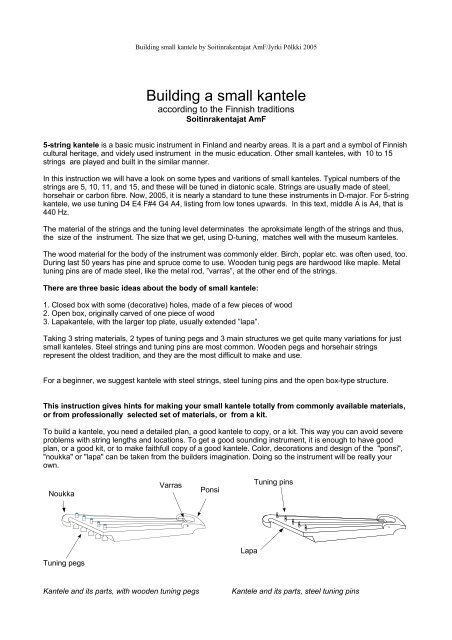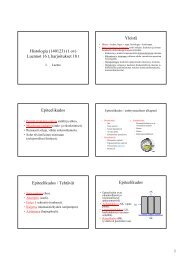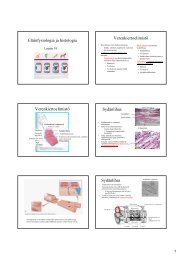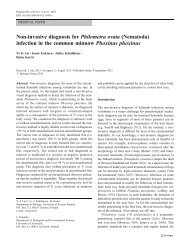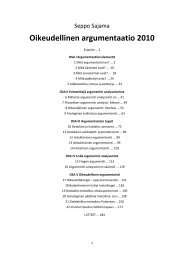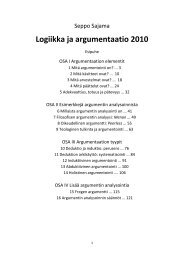Building a small kantele - Joensuu
Building a small kantele - Joensuu
Building a small kantele - Joensuu
Create successful ePaper yourself
Turn your PDF publications into a flip-book with our unique Google optimized e-Paper software.
<strong>Building</strong> <strong>small</strong> <strong>kantele</strong> by Soitinrakentajat AmF/Jyrki Pölkki 2005<br />
<strong>Building</strong> a <strong>small</strong> <strong>kantele</strong><br />
according to the Finnish traditions<br />
Soitinrakentajat AmF<br />
5-string <strong>kantele</strong> is a basic music instrument in Finland and nearby areas. It is a part and a symbol of Finnish<br />
cultural heritage, and videly used instrument in the music education. Other <strong>small</strong> <strong>kantele</strong>s, with 10 to 15<br />
strings are played and built in the similar manner.<br />
In this instruction we will have a look on some types and varitions of <strong>small</strong> <strong>kantele</strong>s. Typical numbers of the<br />
strings are 5, 10, 11, and 15, and these will be tuned in diatonic scale. Strings are usually made of steel,<br />
horsehair or carbon fibre. Now, 2005, it is nearly a standard to tune these instruments in D-major. For 5-string<br />
<strong>kantele</strong>, we use tuning D4 E4 F#4 G4 A4, listing from low tones upwards. In this text, middle A is A4, that is<br />
440 Hz.<br />
The material of the strings and the tuning level determinates the aproksimate length of the strings and thus,<br />
the size of the instrument. The size that we get, using D-tuning, matches well with the museum <strong>kantele</strong>s.<br />
The wood material for the body of the instrument was commonly elder. Birch, poplar etc. was often used, too.<br />
During last 50 years has pine and spruce come to use. Wooden tunig pegs are hardwood like maple. Metal<br />
tuning pins are of made steel, like the metal rod, ”varras”, at the other end of the strings.<br />
There are three basic ideas about the body of <strong>small</strong> <strong>kantele</strong>:<br />
1. Closed box with some (decorative) holes, made of a few pieces of wood<br />
2. Open box, originally carved of one piece of wood<br />
3. Lapa<strong>kantele</strong>, with the larger top plate, usually extended ”lapa”.<br />
Taking 3 string materials, 2 types of tuning pegs and 3 main structures we get quite many variations for just<br />
<strong>small</strong> <strong>kantele</strong>s. Steel strings and tuning pins are most common. Wooden pegs and horsehair strings<br />
represent the oldest tradition, and they are the most difficult to make and use.<br />
For a beginner, we suggest <strong>kantele</strong> with steel strings, steel tuning pins and the open box-type structure.<br />
This instruction gives hints for making your <strong>small</strong> <strong>kantele</strong> totally from commonly available materials,<br />
or from professionally selected set of materials, or from a kit.<br />
To build a <strong>kantele</strong>, you need a detailed plan, a good <strong>kantele</strong> to copy, or a kit. This way you can avoid severe<br />
problems with string lengths and locations. To get a good sounding instrument, it is enough to have good<br />
plan, or a good kit, or to make faithfull copy of a good <strong>kantele</strong>. Color, decorations and design of the "ponsi",<br />
"noukka" or "lapa" can be taken from the builders imagination. Doing so the instrument will be really your<br />
own.<br />
Noukka<br />
Tuning pegs<br />
Varras<br />
Ponsi<br />
Lapa<br />
Tuning pins<br />
Kantele and its parts, with wooden tuning pegs Kantele and its parts, steel tuning pins
<strong>Building</strong> <strong>small</strong> <strong>kantele</strong> by Soitinrakentajat AmF/Jyrki Pölkki 2005<br />
When making a <strong>kantele</strong> from selected set of materials, or just ordinary woodstore materials, a good choice is<br />
to carve the instrument from one piece of wood. Even then "ponsi" is a separate piece of wood. For the body<br />
we need a piece of wood 5 cm thick, 12-14 cm broad and 65-75 cm long. Take the measures from a plan or<br />
an existing instrument. Any soft wood will do, elder and poplar are most popular.<br />
1.Saw first the outline of the <strong>kantele</strong>. Next, make the wedge shape of the body. Height of the body is some<br />
3.5 - 4 cm at ”ponsi” end and 5 cm at ”lapa” end.<br />
2. Hollow the box from down. It is good to drill large round holes at least at the corners of the area to be<br />
hollowed. If you have a good, flat end drill and a bench drilling machine with reliable stopper, most of the work<br />
can be done by them.<br />
Set the drill stopper so, that it leaves some 5-7 mm of wood untouched when pressed to the bottom. Make a<br />
trial with some scrap wood! Then drill the hollow area with overlapping holes all over. Most of the wood can<br />
be taken out by this method.<br />
Use chisels and knives to carve the inside clean and smooth. You can remove all the marks of the<br />
machinework, if you like. Final thickness of the top is 5-7 mm.<br />
3. Saw the part under "lapa" away with a hand saw. If you are making a <strong>kantele</strong> with wooden pegs, make<br />
sure that there is enough space for the handles of the pegs. The final thickness for "lapa" should be 16 mm<br />
for the wooden pegs, 20-22 mm for the steel tuning pins.<br />
4. Make the "ponsi" of extra piece of wood. Use the plan or the model to get the right shape. Straighten its<br />
bottom and make it fit to the narrow end of top. Glue on place.<br />
5. Now is good time to smoothen the <strong>kantele</strong> to give it nice looks. Give it colour or not, and give it a coat of<br />
linseed oil, wax, or both.<br />
6. "Varras" is the steel rod where the strings will be knotted. It will be set to holes, that are drilled to the arms<br />
of ”ponsi”. Make varras perpendicular to the middle line of the <strong>kantele</strong> body. Varras is a steel rod 5 mm dia.<br />
7. For the steel tuning pins, make holes with a drill. The drill should be 0,5 mm <strong>small</strong>er than the pin. Mark the<br />
locations of the holes from the plan or the model.<br />
For the wooden pegs drilling the holes is more complicated. Take the diameter of the drill from the narrow tip<br />
of the peg. Then, in best case you have a conical reamer to enlargen the hole to fit the conical peg. If a<br />
reamer is not available, try a round file and later sanding paper that is vrapped around a peg. Do this<br />
sensitive work little by little, not to spoil the hole too big.<br />
The peg should come some 20 mm out from the top side, and the handle should be 2-3 mm from the<br />
underside of "lapa". Finally, the handles should be so short, that they do not touch the table when the<br />
instrument is put on table. For steel string, there should be a hole trough, about diameter 1 mm, at 15 mm<br />
distance from the top. For horsehair- and fibrecarbon strings, 5 mm deep cut at the narrow end of the peg is<br />
better. Make it with a saw.<br />
8. Use steelwire, so called pianowire, of 0,35 mm dia for the strings. You need a tuning wrench to wind the<br />
pins and long tipped pliers to handle the wire.Tie the strings according to the picture:<br />
Tying of the steel string on steel pin, horse-hair-string on a peg, and tying of any string to the ”varras”
<strong>Building</strong> <strong>small</strong> <strong>kantele</strong> by Soitinrakentajat AmF/Jyrki Pölkki 2005<br />
When using horsehair or fibrecarbon, take a bunch of 15-25 hairs with plenty of extra length. This extra is<br />
needed for the knots and tying. Make the hairs parallel and make a knot at one end. This knotted end will be<br />
tied around the "varras", in the same manner as the steel string, and pulled tight. Next, the hairs are combed<br />
parallel again and carefully to equal tension. When none of the hairs has loose, the bunch will be wound<br />
around from the free end. Keep the bunch tight so that knurls do not appear. When the bunch looks like<br />
knitting thread it is ready for the tuning peg.<br />
Put the wound bunch to the slot that is at the tip of the peg. Ask a helping hand to keep the string tight so<br />
that it will not form knurls. Then, keep the string in its slot by one hand, and begin to wind the peg by the<br />
other.<br />
There should be some 3-7 rounds around the peg or the pin.<br />
9. The knot of the string around the varras is very important detail. Actually, it makes most of the speciality of<br />
the steeel string <strong>kantele</strong> sound. It makes the sound colour fluctuate, a bit in a slow vibratolike manner. You<br />
can even regulate this fluctuation by making the knot looser or tighter. Diameter of the varras matters, too.<br />
10.Put the rest of the strings in the same manner, tune the <strong>kantele</strong> and play!<br />
Other <strong>small</strong> <strong>kantele</strong>s<br />
The general measures are again based on tuning level and the string material. The <strong>kantele</strong>s with 10 to 15<br />
strings are most commonly tuned so, that they include typical 5-string <strong>kantele</strong> that begins from the string nro<br />
4 when counting from the lowest sounding string. The 3 strings, which sound lower than the 5-string-area,<br />
must be longer. Lowest, the A3-string should be 63-72 cm long. The higher strings shoud be about half<br />
lenght when compared to the tones one octave lower.<br />
The criteria for proper string length is easy to find by trial: For any planned tuning level, the string is too long if<br />
it breaks. The string is too short, if it sounds bad and the pitch glides when playing loud.<br />
Like with the 5-string <strong>kantele</strong>, get a good plan or make a copy of a good existing instrument.<br />
11-string traditional model and 11- and 15-string modern lapakannel.<br />
25.4.2005 jp<br />
Soitinrakentajat AmF<br />
Tuikkalantie 2<br />
79100 Leppävirta<br />
Finland<br />
e-mail: soitinrakentajat@amf.inet.fi<br />
URL: www.soitinrakentajatamf.fi<br />
Tel. +358-17-5540125<br />
Fax:+358-17-5540125<br />
Copy for private use only. If you do copy, include the original publisher/maker


